CDS-5D ( Cooled eos 5D Mark III )
Canon DSLR is known for its direct and intuitive user interface design, which is an optimal tool for amateur astronomers to acquire the Astro images with its excellent color rendering on low-light imaging with low noise than other comparable models available.
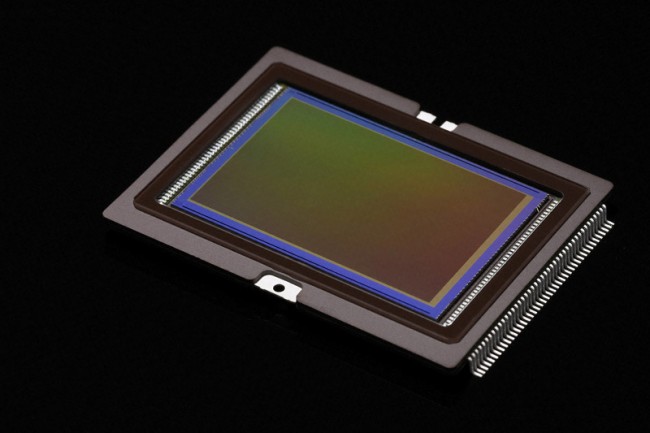 Especially 5D Mark III is a top of the line camera that carries a full-frame image sensor. It is a great model with the most reduced noise while supporting the astonishing ISO 102,800 which is 32 times of the standard ISO 3,200. It is indeed Cannon technology’s flagship model with the engineered high-quality camera shielding, the improved image sensor technology, and the great noise removal algorithms through the up-to-date Digic5+ image processor.
Especially 5D Mark III is a top of the line camera that carries a full-frame image sensor. It is a great model with the most reduced noise while supporting the astonishing ISO 102,800 which is 32 times of the standard ISO 3,200. It is indeed Cannon technology’s flagship model with the engineered high-quality camera shielding, the improved image sensor technology, and the great noise removal algorithms through the up-to-date Digic5+ image processor.
CentralDS expended the feature sets of Canon 5D Mark III and re-envisioned as CDS-5D to accommodate its high performance with extreme low-light imaging condition.
Disassembly of 5D mark III/ Reconstruction Learn more >
Cooled 5D markII / CDS-5D Compared Lean more >
CDS-600D / CDS-5D Compared Learn more >
Dark Frame Compared Learn more >
CDS-5D was developed with the following three concepts in mind for professional astrophotography camera should be.
1. An astronomical camera with simple interchangeable filter system
2. An accurate cooling temperature control
3. A full frame camera with maximum cooling performance
Specifictions
[table id=5 /]
1.One touch 2″ drop-in filter holder
In order to prevent dew formations on image sensor, Hoya MC clear filer is used to seal the chamber to block outside air.
Also developed Drop-In Filter Holder between the space where clear filter and lens mount ring are resided in. Drop-in filter accepts filter with size 48mm or 52mm.
For instance, On CDS-600D, screw type was used to hold and change filters so in order to change filter and the screw type holder had to be detached and re-attached each time from OTA and lens which makes bit of tediousness on changing different filter.
CDS-5D’s improved filter mounting system allows a user to simply drop-in their filters while attached with lens or OTA. Since a filter goes in between Lens and imaging sensor, it’s possible to combine various optical systems with little efforts. A user is able to composite visible/infrared channels, Hydrogen Alpha (Ha) and Narrow Band channels easily where previously difficult to achieve.
Recommended filters: UV/IR cut, R72, RGB color filters, Ha pass filter, Narrow band Ha, HB, SII, Light pollution filter etc.
2.3 point alignment on mount ring
An image sensor requires an exact perpendicular alignment to its optical axis to maintain preciseness, and an un-modified camera has three fixed support on its mirror box against CMOS frame to support and maintain its axis. CDS-5D incorporates an adjustable ring in between the sealed chamber and lens mount ring for easy adjustment of misalignment changes like those similar method found in reflective mirror cell where user only need three knobs adjustment for connecting alignment. Adjusting ring for optical axis in an event of harsh condition also does not require disassembling of the mounting ring, and the ring itself is composed of high rigidity stainless steel that is not effected by varying temperature conditions.
3.Integrated sealed sensor chamber and camera housing
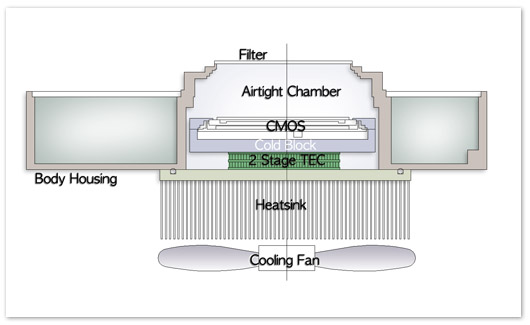
On Astro60D and Cooled 5D Mark II model’s modifications where it has separated camera housing and the chamber, it may have imposes on change of an accurate optical axis in the event where strong external force was applied to the sealed chamber and camera housing.
On CDS-600D, we have significantly increased the structural integrity of the body by combining a sealed chamber with the camera housing though, it also created a large internal space where it required Molecular Sieve desiccant to prevent condensation formation as part of solution.
This structural principle of CDS-6000D was improved in CDS-5D while still keeping the integrated sealed chamber and housing structure by making the smaller sized sealed chamber to embrace only the CMOS but not requiring a separate drying formation to prevent the internal condensation. This method is considered a stable and complete condensation prevention concept and allows the improved prevention power for the optical axis change.
4.2 Stage TEC Cooler
In order to increase cooling performance for the CDS-5D, upgraded Peltier Module with 2-stage Qmax with 65Watts and DTmax with 80 ° C are installed, unlike most other CentralDS’ Cooled DSLR where single stage Qmax/36Watts, DTmax = 71 ° C Peltier Modules were used.
5.High efficiency heat sink and cooling fan
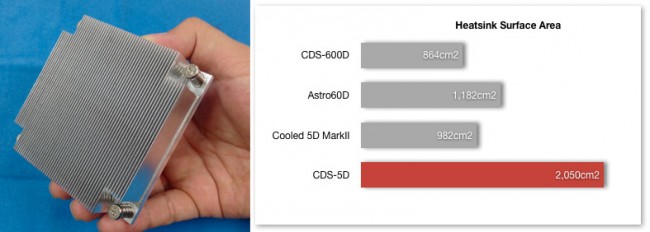
Other deciding factors of cooling performances are the heat-sink and cooling fans. Although there are several large size heat-sink units available in the market, most of them use heat pipe to maintain its varying temperatures, which is not appropriate for Astro-Imaging camera due to its big phase difference because they lead to the big difference in the cooling performance.
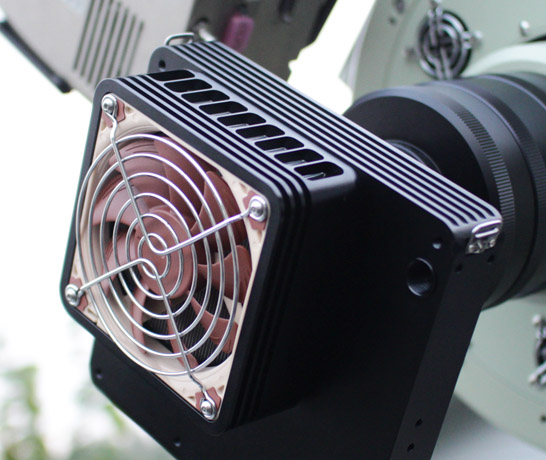
CDS-5D adopted the high-efficiency, high-density aluminum 90x90mm Skiving fin heat sink. This is the largest heat-sink that is being used on all CDS models and it covers the biggest heatproof area.
The high efficiency silent cooling fan that supplies the constant air flow to the heat-sink is the 92mm cooling fan from an Austrian company Noctua, who is well known by the outstanding blade design empowering the silent and vibration free high-performance.
6.Timer Release & Wifi SD Memory
CDS-5D comes with the pre-installed 16GB Wi-Fi SD memory from Transcend. To achieve the Stand Alone capability, CDS-5D supports standard Canon Timer Remote Controller TC-80N3 in a way it can be used to control CDS-5D without PC connectivity. Once a picture is taken using TC-80N3, the files can be then viewed on your laptop or any smart devices via Wi-Fi connection. Also, the installed SD card is replaceable as needed.
7.Finder hole
DSLR comes with Pentaprism equipped optical finder to help a user to capture objects in desired frames with little efforts. However when using a camera lens for CDS-600D modified for astro-imaging purpose, we have noticed a bit of challenges with the precise pointing of an object on the frame due to the lack of a finder. This got improved in CDS-5D by additionally installing the finder hole and enabled to easily capture the desired objects even at night.
8.3-inch direct focusing adapter
CDS-600D uses a 2-inch nose piece to be connected to a telescope, but the much heavier CDS-5D uses 3-inch direct focusing adapter to withstand its weight and stability. A 72mm thread were used to hold connector between a camera and an adapter to secure its optical axis and rigidity with OTA.
9.PID Temperature controller
In order to control the temperature of the CMOS sensor, CentralDS has developed a DTC-3 controller that manages electronic current output for Peltier module to control temperature. DTC-3 is high performance external controller device with the accuracy of +0.5~-0.5°C and is designed for easy use as well. DTC-3 controller is included as standard item for CDS-5D and is designed to reach desired temperature at the shortest time possible. By enabling a user to control the temperature in detail with accuracy, a user can save the effort of taking the dark frame pictures every single time and can easily produce a high quality astro-image picture because a user can easily adjust the dark frame on the pictures taken previously at each temperature.
10. X-ray Views and Dimensions
Disassembly of 5D mark III/ Reconstruction Learn more >
Cooled 5D markII / CDS-5D Compared Lean more >
CDS-600D / CDS-5D Compared Learn more >
Dark Image Compared Learn more >


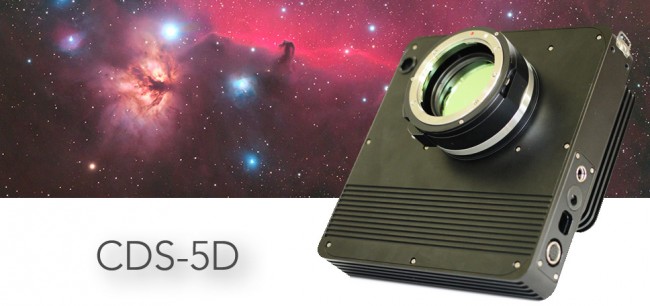
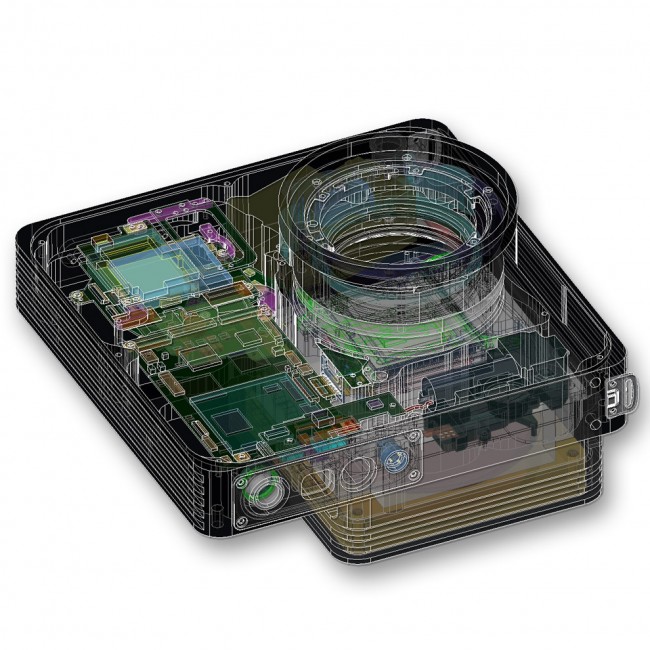
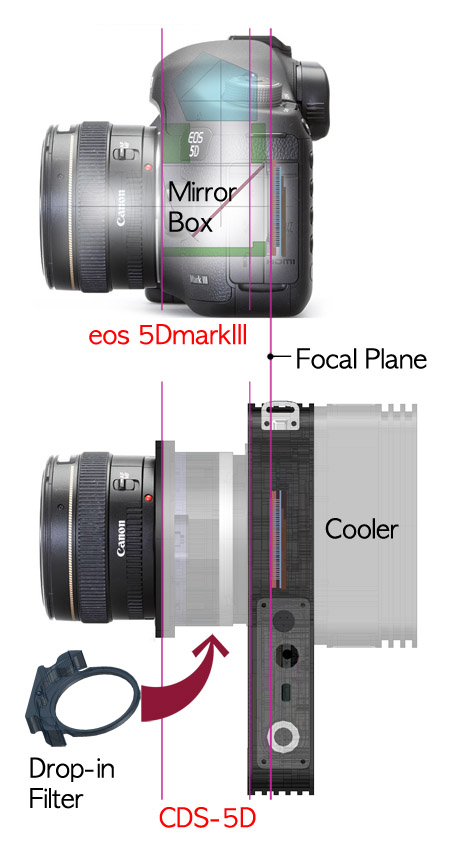
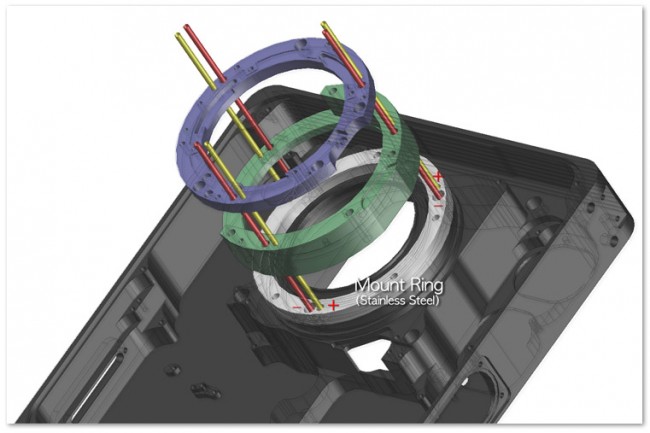

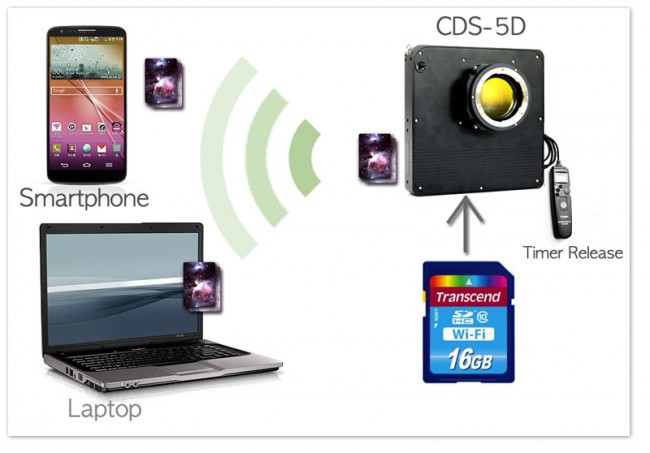

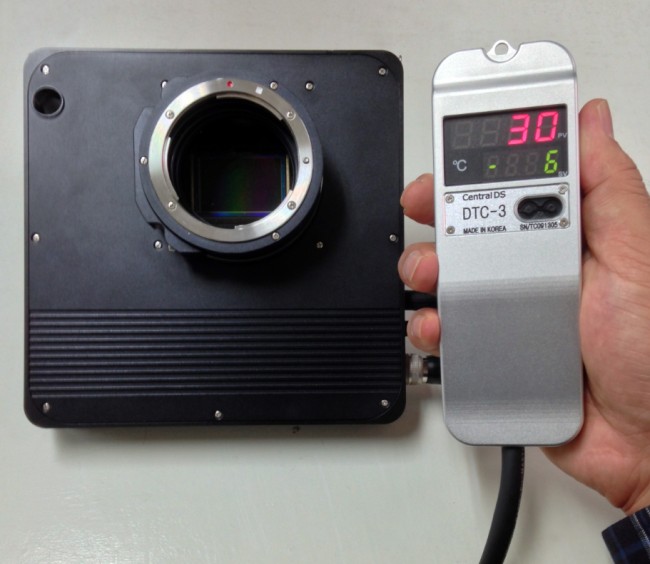
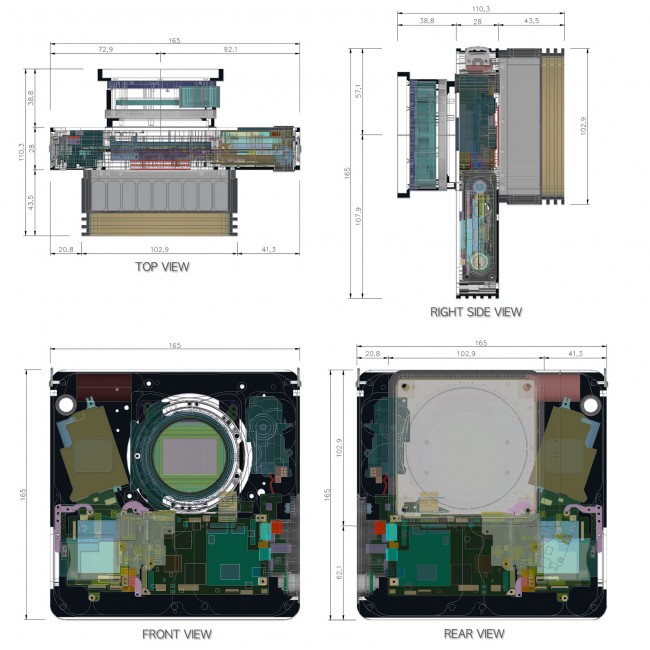
I’m the Hong Kong guy using your Astro 60D, so many friends are interested at the new CDS-5D in my facebook !!!
Thanks for your interest in CDS-5D. CSS-5D will expand your astro imaging to professional field.
Hello:
Will you be providing a way to connect a 2″ nose piece to the CDS-5D without the camera mount being attached. Similar to how it was done with the CDS-600D. This will allow minimum back focus and less vignetting on this full frame sensor. Sort of like on a CCD camera.
Ralph
Any comments on my above suggestion about a nose piece?
Sorry for my late reply.
CDS-600D set include a 2″ field rotator, 42mm thread ring and 48mm thread ring.
Using 42mm or 48mm thread ring and field rotator combination + 42mm or 48mm extension tube you can attach CDS-600D to your OTA. If you 48mm thread extension tube , maybe you will get about 45mm diameter clear aperture.
We designed a new [2″ nose piece for CDS-5D]. please refer to linked image.
Using this you can get 48mm diameter clear aperture with CDS-5D.
[2″ nose piece for CDS-5D] is not included in CDS-5D set, it ‘s optional accessary.
http://www.centralds.net/cam/wp-content/uploads/2014/04/cds-5d-adapter1.jpg
http://www.centralds.net/cam/wp-content/uploads/2014/04/cds-5d-adapter2.jpg
http://www.centralds.net/cam/wp-content/uploads/2014/04/cds-5d-dadapter_ring.jpg
It looks like all of the adapters will be installed on top of the camera mount piece. Is there a setup or arrangement that will allow a direct connection to the camera with a 48mm clear aperture 2″ nose piece without the camera mount and removable filter section?
The idea is to reduce the back focus to the sensor which will in turn reduce any possible vignetting.
Ralph
Drop-in filter is a main concept of CDS-5D. the clear filter fixed to camera and focal plane alignment ring are can not removed in any case.
The “U Shaped drop-in filter base” is holding the filter.
Therefore 2″ nose piece to camera body direct connection is impossible in CDS-5D. If you want minimized vignetting you can use 3″(77mm) adapter ring. 52mm thread filter holder and hoya 52mm UV/IR cut filter + 77mm extension ring will provide more advantage.
http://www.centralds.net/cam/wp-content/uploads/2014/05/002.jpg
Your pictures show a widefield canon lens attached but how do you attach the camera to a tripod if the lens doesn’t have a tripod collar?
If you use a longer lens such as a 200mm with a tripod collar, is the camera to lens connection strong enough to support the 1.55kG camera load?
You can use the ‘L’ shape tripod adapter included with CDS-5D set.



It’s so rigid and support the body without any torsion. In the camera body we formed a H shaped spinal frame and this is combined to ‘tripod adapter’.
Belows are the iamges of Tridpod Adapter.
Thank you.